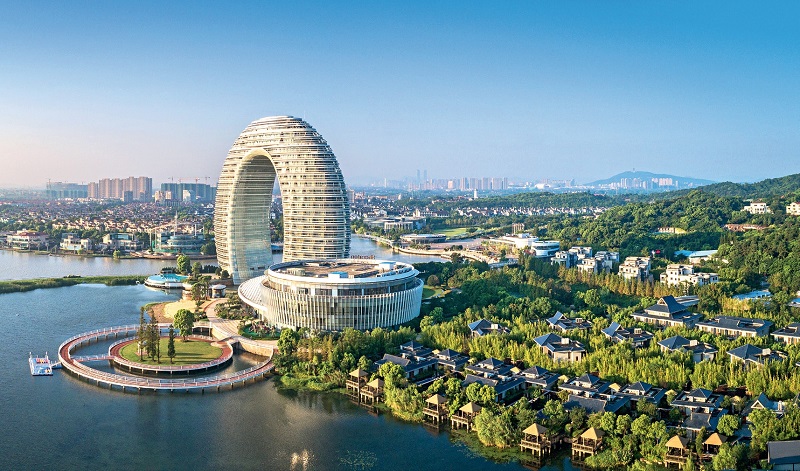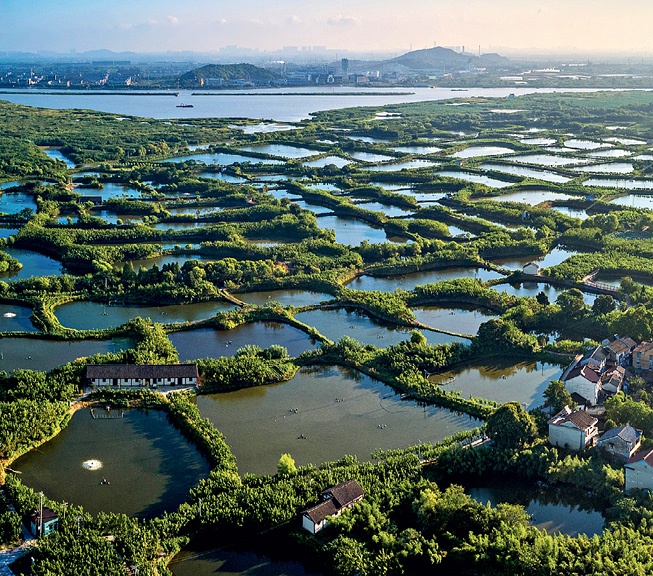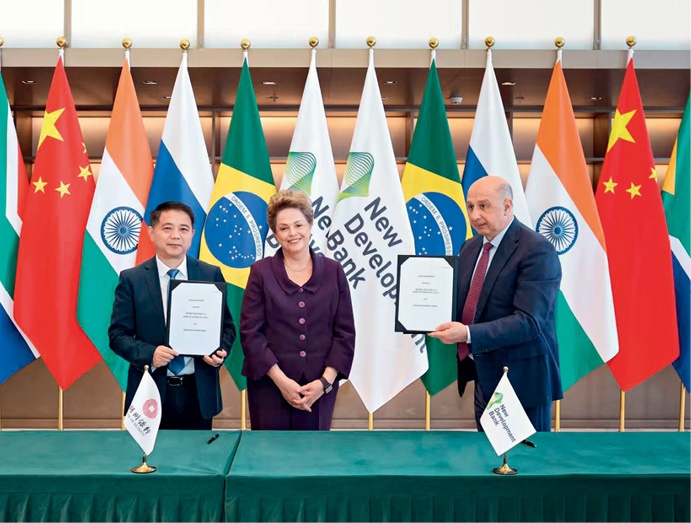
The Taihu Lake is reborn as a tourism landmark thanks to the local government’s ecological governance and green development.
This year marks the 20th anniversary of the vision “lucid waters and lush mountains are invaluable assets,” which reveals the intrinsic link between economic development and ecological protection. As the birthplace of this idea, representatives of Huzhou City in east China’s Zhejiang Province were invited to the 2025 United Nations High-Level Political Forum on Sustainable Development in New York on July 14. At the forum, Executive Vice Mayor Wang Zongming delivered a speech titled “Beautiful China, Dynamic Huzhou,” sharing the city’s sustainable development practices and stories in four aspects: ecology, industry, culture, and urban–rural integration.

The Huzhou mulberry dyke & fish-pond system (HMFS) stands out as a living revival of 2,500-year-old circular agriculture.
A Win-Win for Ecology and Economy
Located in the heart of China’s most developed region – the Yangtze River Delta, Huzhou also sits on the shores of the Taihu Lake, the country’s third-largest freshwater lake. Once the cradle of silk, porcelain, fine writing-brushes, and tea culture, the city is now home to 3.44 million residents and boasts a per-capita GDP of more than US $17,000.
“We took detours in the development path before,” said Wang. “The reason Huzhou now enjoys a sound ecology is that we have unswervingly put the environment first and pursued green development, achieving a genuine win-win in which ecological protection and economic growth reinforce each other,” Wang said.
The green story began in Yucun, a once-remote mountain village in Anji County. With little arable land, villagers lived off the rocky hills, blasting quarries and running cement plants. GDP rose quickly, but dust and polluted streams clouded the landscape. In 2003, answering the provincial government’s call to build an eco-friendly Zhejiang, Yucun shut its mines and factories and pivoted toward an eco-economy.
On August 15, 2005, Xi Jinping, then secretary of the CPC Zhejiang Provincial Committee, visited Yucun. He praised the turnaround and put forward the idea “lucid waters and lush mountains are invaluable assets,” pointing the way forward for Yucun and countless other villages across China.
Two decades on, Yucun has become a global model of green transition. Twenty years of unwavering effort have turned the tiny village into a nationally designated “Beautiful and Livable Demonstration Village,” and one of the first villages worldwide to be listed by the UN World Tourism Organization as a “Best Tourism Village.” Today, businesses are flourishing and residents prosper in Yucun.
In July 2022, the village launched its “Global Partners” program. Chen Zhe, a young entrepreneur who had spent 10 years in Shanghai, answered the call. He and his friends converted an abandoned cement plant into a rural library, and opened a gift shop themed on Chinese animation, which soon became a must-visit destination. His success attracted more young entrepreneurs. Within just two years, more than 60 “Global Partners” and new-economy projects have been established in Yucun, bringing over 1,200 young people to live and work there full-time.
Music festivals, craft-coffee shops, designer boutiques and other trendy events have followed, allowing villagers to earn a living from tourism, ecology and profit-sharing dividends. In 2024, the village received 1.22 million visitors and generated tourism revenue of RMB 60 million. Per-capita net income has jumped from RMB 8,700 in 2005 to RMB 74,000 in 2024, more than a seven-fold increase.
Yucun is not an isolated case. “The Taihu Lake Longemont Paradise is an inspirational effort of how a scarred mountainside was reborn as a tourism landmark,” said Wang.
The site of the Taihu Lake Longemont Paradise complex was once a cluster of abandoned quarries up to 70 meters deep, an “ecological scar” known to locals. Instead of simply back-filling and re-greening, Huzhou government chose to treat the ruined landscape as a strategic asset. Following a “quarry-to-architecture” approach, the city fused ecological restoration with cultural tourism, building a mega resort out of the existing topography.
Guest-room balconies now overlook sheer cliff walls and emerald quarry lakes. A 70-meter drop has become a natural amphitheater and indoor water-park. Wetlands and canals connect the complex to the Taihu Lake itself, turning stagnant pits into a crystal-clear lagoon. The project has created 20,000 direct jobs and 80,000 indirect ones, realizing ecological, social and economic gains in a single stroke.

Yucun Village has turned into a nationally designated “Beautiful and Livable Demonstration Village,” and was one of the first villages worldwide to be listed by the UN World Tourism Organization as a “Best Tourism Village.”
Innovation’s Timeless Value
Long hailed as the “Land of Silk” and the “Home of Fish and Rice,” Huzhou boasts eight UNESCO heritage sites. Among them, the Huzhou mulberry-dyke & fish-pond system (HMFS) stands out as a living revival of 2,500-year-old circular agriculture.
The system harks back to the ancient Taihu Lougang waterworks, a 2,500-year-old network of canals and locks that remains the pinnacle of pre-modern hydraulic engineering, according to Wang. Its genius lies in a closed-loop design: the waste of fish raised in ponds fertilizes the water; pond silt is dredged onto dykes to grow mulberries; mulberry leaves feed silkworms; silkworm waste feeds the fish, with zero external inputs and zero pollution.
Recent municipal regulations, protected zones, dedicated funds, R&D hubs and farm-tourism integration measures have breathed new life into the HMFS. Today, the site attracts more than a million visitors annually and has inspired a new generation of circular models featuring solar-panel pastures, rice-fish symbiosis, and livestock-crop linkages, proving that ancient wisdom can power modern green growth.
Huzhou is now sharing its green development practices with other countries. Through South-South cooperation, the city has localized mulberry-fish loops in over 30 developing countries, helping with the fight against poverty and restoration of degraded land. The “Heaven-and-Man-in-Harmony” philosophy has become a global reference for eco-civilization, rural revitalization and East-West dialogue.
“Sustainability permeates every sector of Huzhou,” Wang said. The city has locked onto a “green, low-carbon, circular and smart” industrial track, retrofitting legacy industries, scaling strategic emerging sectors and pre-deploying future low-carbon technologies.
Green finance is the catalyst. In 2017 Huzhou launched China’s first pilot zone for green finance reform. Twenty-six local standards and an ESG and carbon-account digital rating system now give enterprises a “green profile,” allowing banks to price loans by sustainability performance – higher credit lines, lower rates, and faster approval. With an annual growth rate of 40-plus percent, green loans account for more than 30 percent of total lending. And its green-bond issuance ranks among the highest in the Yangtze River Delta.

The New Development Bank and the Bank of Huzhou signs a non-sovereign loan agreement to finance sustainable infrastructure projects in Huzhou, Zhejiang Province, on May 28, 2024.
Beautiful China, Dynamic Huzhou
Nestled amid mountains, rivers, forests, farmland, lakes, and grasslands, Huzhou harbors one of the most complete suites of ecological assets in east China. The city shelters an extraordinary array of globally rare species – the Chinese alligator, Anji salamander, and crested ibis.
At the 15th meeting of the Conference of the Parties to the UN Convention on Biological Diversity (COP15) held in Kunming in 2021, Huzhou was designated an “International Cooperation Demonstration Zone for Ecological Civilization” and honored as a “Biodiversity Champion City.”
“To develop high-quality space for sustainable development, we have built a full-spectrum policy architecture for ecological protection,” Wang explained. “Huzhou was the first city worldwide to act on the Kunming-Montreal Global Biodiversity Framework, and we initiated the Taihu Lake Rim Kunming-Montreal Implementation Alliance, creating a regional platform for biodiversity exchange and joint action.”
Deqing County, for example, has restored wetlands, converted fish-ponds to marshland, linked water courses, and re-established native vegetation to recreate a homeland for the crested ibis. By pairing ibis conservation with bird-watching tourism, the county has hatched an “avian economy” that powers rural revitalization.
Today, as a National Forest City and National Garden City, Huzhou’s forest coverage stands at nearly 50 percent. In 2024, built-area green coverage reached 44.2 percent, ranking first among all prefecture-level cities in Zhejiang.
According to the National County Tourism Research Report 2025 released by Xinhua Daily Telegraph, three counties under Huzhou – Anji, Changxing and Deqing – have remained among the top 10 of China’s 1,866 counties for overall tourism strength for seven consecutive years.
“Huzhou’s story is a living demonstration that, ‘lucid waters and lush mountains are invaluable assets,’ and it [has shown] steadfast progress toward [reaching] the UN 2030 Agenda for Sustainable Development,” Wang said. “By putting ecology first and pursuing green growth, we have forged a path where ecological beauty, industrial renewal, and shared prosperity advance together,” he added. More and more international visitors are coming to see the sustainable development in dynamic Huzhou firsthand, where they can truly experience a Beautiful China.